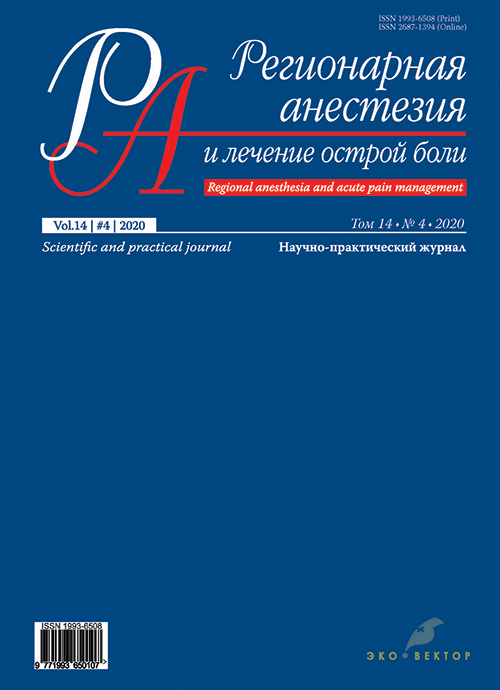Возможности психологического сопровождения пациентов с хронической болью при мультидисциплинарном подходе
- Авторы: Хиновкер В.В.1, Алькина М.В.1, Черномурова П.А.1, Газенкампф А.А.2
-
Учреждения:
- ФГБУ «Федеральный Сибирский научно-клинический центр» ФМБА России
- 2ФГБОУ ВО «КрасГМУ им. проф. В.Ф. Войно-Ясенецкого» Министерства здравоохранения Российской Федерации
- Выпуск: Том 14, № 4 (2020)
- Страницы: 206-216
- Раздел: Оригинальные исследования
- Статья получена: 01.03.2021
- Статья одобрена: 01.03.2021
- Статья опубликована: 08.12.2020
- URL: https://rjraap.com/1993-6508/article/view/62398
- DOI: https://doi.org/10.17816/RA62398
- ID: 62398
Цитировать
Полный текст
Аннотация
Актуальность. Несмотря на то что боль значительно изучена, её лечение остаётся актуальной проблемой. Боль могут формировать различные факторы как на физиологическом, так и на психологическом уровне. У пациентов с хронической болью развиваются специфические психологические проблемы. Рассмотрение боли через призму психосоциального подхода предполагает использование и разработку новых психотехнологий.
Цель: изучить возможности улучшения эмоционального состояния и снижения болевой интенсивности у пациентов с хронической болью в спине с помощью использования техник «mindfulness» и техник когнитивно-поведенческой терапии.
Материалы и методы. Выборка исследования состоит из 30 пациентов с хроническими болями в спине (20 женщин, 10 мужчин), которые находились на амбулаторном лечении в центре лечения боли.
Результаты и обсуждение. Результаты представленного в статье исследования, а также анализ и обобщение источников литературы позволили нам подготовить программу психологического сопровождения, основанную на таких направлениях как когнитивно-поведенческая и техник mindfulness. Вся работа состояла из трех блоков: диагностика, непосредственно сами упражнения, повторная диагностика. Экспериментальные данные показали возможность и доказали эффективность снижения уровней депрессии и тревожности, а также снижение уровня боли.
Выводы. У пациентов с хронической болью часто присутствуют симптомы депрессии и тревожности разной выраженности, а также снижено качество жизни. Программа медико-психологического сопровождения с использованием техник mindfulness и когнитивно-поведенческой терапии положительно повлияла на уровень тревожности, депрессии и интенсивности боли. Программа медико-психологического сопровождения способствовала тому, что пациенты обучились методам саморегуляции, саморелаксации.
Ключевые слова
Полный текст
Об авторах
Владимир Владимирович Хиновкер
ФГБУ «Федеральный Сибирский научно-клинический центр» ФМБА России
Автор, ответственный за переписку.
Email: vhinov@hotmail.com
ORCID iD: 0000-0002-3162-6298
к.м.н., заведующий отделением анестезиологии и реанимации ФГБУ «Федеральный Сибирский научно-клинический центр» ФМБА России
Россия, 660037, Красноярский край, г. Красноярск, ул. Коломенская, д. 26, а/я 6213М. В. Алькина
ФГБУ «Федеральный Сибирский научно-клинический центр» ФМБА России
Email: vhinov@hotmail.com
ORCID iD: 0000-0001-9168-5823
Россия, 660037, Красноярский край, г. Красноярск, ул. Коломенская, д. 26, а/я 6213
П. А. Черномурова
ФГБУ «Федеральный Сибирский научно-клинический центр» ФМБА России
Email: vhinov@hotmail.com
ORCID iD: 0000-0001-7592-2390
Россия, 660037, Красноярский край, г. Красноярск, ул. Коломенская, д. 26, а/я 6213
А. А. Газенкампф
2ФГБОУ ВО «КрасГМУ им. проф. В.Ф. Войно-Ясенецкого» Министерства здравоохранения Российской Федерации
Email: vhinov@hotmail.com
ORCID iD: 0000-0001-8515-2991
Россия, 660022, Красноярск
Список литературы
- Комлева Н.Е., Спирин В.Ф. Качество жизни у пациентов с болью в спине // Бюллетень Восточно-Сибирского научного центра Сибирского отделения Российской академии медицинских наук. 2013. Т. 3–1 № 91. С. 19–22
- Рачин А.П. Хроническая боль в спине (подходы к диагностике и терапии) // Поликлиника. 2014. № 5. С. 45–42.
- Данилов А.Б. Биопсихосоциальная модель и хроническая боль // Российский журнал боли. 2010. Т. 1. № 26. С. 3–7.
- Токарева А.А., Мельников М.Е., Шубина О.С., Несина И.А., Мигуськина Е.И. Исследование психологических коррелятов хронического болевого синдрома // Бюллетень сибирской медицины. 2012. Т. 11. № 1. С. 83–90.
- Зиновьева О.Е., Рожков Д.О. Мультидисциплинарный подход к лечению хронической неспецифической боли в спине // Регулярные выпуски «РМЖ». 2018. № 4–2. С. 93–96.
- Швачкин С.Д., Лазарева Е.А. Возможности психотерапии в комплексной реабилитации пациентов с хроническими болями в спине // Медицинский альманах. 2016. № 5. С. 179–182.
- Gatchel R.J. Early development of physical and mental deconditioning in painful spinal disorders // Contemporary conservative care for painful spinal disorders. 1991. P. 278–289.
- Melzack R. Sensory, motivational and central control determinants of pain: a new conceptual model // The skin senses. 1968. P. 423–443.
- Ласков В.Б., Алексеенко Ю.В. Роль ятрогенных факторов в катастрофизации боли // Интегративные тенденции в медицине и образовании. 2017. Т. 4. С. 9.
- Булюбаш И.Д., Млявых С.Г. Клинические и психодиагностические маркеры устойчивости хронического болевого синдрома в пояснично-крестцовой области после оперативного лечения // Вопросы травматологии и ортопедии. 2013. № 1. С. 7–13.
- Голубев В.Л., Данилов Б.А. Эмоциональные, социокультурные факторы и хроническая боль // Регулярные выпуски «РМЖ». 2014. № 0. С. 6.
- Данилов Б.А. Новые подходы в лечении пациентов с хронической болью // Лечащий врач. 2009. № 4. С. 34–38.
- Данилов А.Б. Психопатология и хроническая боль // Consilium medicum. 2008. № 2. С. 50–55.
- Пеннер В.А., Борисенко В.В. Боль в нижней части спины при остеопорозе и синдромы, которые ее сопровождают // Украинский морфологический альманах. 2014. № 4. С. 85–88.
- Дюкова Г.М. Новые перспективы лечения хронической боли и депрессии // Consilium Medicum. 2007. № 8. С. 85–88.
- Вышлова И.А. Результаты применения образовательных программ у пациентов с хронической дорсалгией // Курортная медицина. 2018. № 4. С. 65–69.
- Соков Е.Л., Корнилова Л.Е. Особенности личностного профиля пациентов с хроническим болевым синдромом в спине и нижних конечностях // Медицинский альманах. 2014. № 3. С. 71–73.
- Головачева В.А., Головачева А.А. Психологические методы в лечении хронической неспецифической боли в нижней части спины // Неврология, нейропсихиатрия, психосоматика. 2019. № S1. С. 25–32.
- Robins C. J. Effects of mindfulness-based stress reduction on emotional experience and expression: a randomized controlled trial // J Clin Psychol. 2012. Vol. 68. N 1. P. 117–131
- Kerr C.E. Effects of mindfulness meditation training on anticipatory alpha modulation in primary somatosensory cortex // Brain Research Bulletin. 2011. № 84. P. 96–103
Дополнительные файлы

















